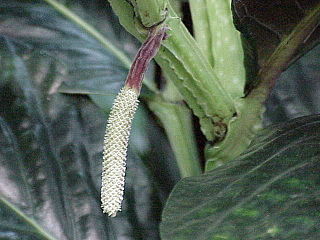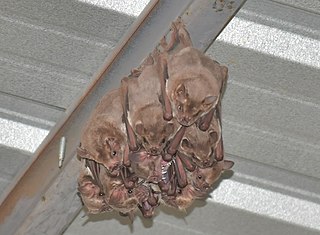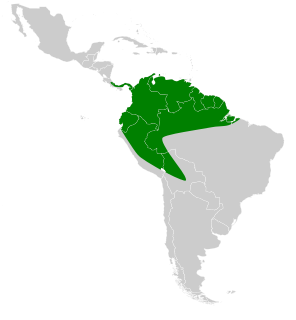
Piper, the pepper plants or pepper vines, is an economically and ecologically important genus in the family Piperaceae.

The spectacled bear, also known as the Andean bear, Andean short-faced bear, or mountain bear and locally as jukumari, ukumari (Quechua) or ukuku, is the last remaining short-faced bear. Its closest relatives are the extinct Florida spectacled bear, and the giant short-faced bears of the Middle to Late Pleistocene age. Spectacled bears are the only surviving species of bear native to South America, and the only surviving member of the subfamily Tremarctinae. The species is classified as Vulnerable by the IUCN because of habitat loss.

The São Tomé shrew is a white-toothed shrew about 3.0 in (7.6 cm) long found only on São Tomé Island, São Tomé and Príncipe. It is listed as a critically endangered species due to habitat loss and a restricted range. It was discovered in 1886. The population continues to decrease, making these animals rare. It is found only on São Tomé Island, a small island that is actually a shield volcano that rises out of the Atlantic Ocean.

The silky short-tailed bat is a bat species from South and Central America. It is found in Bolivia, Brazil, Colombia, Ecuador, French Guiana, Guyana, Panama, Peru, Suriname, Mexico and Venezuela.

An IUCN Red List Critically Endangered (CR) species is one that has been categorized by the International Union for Conservation of Nature as facing an extremely high risk of extinction in the wild. As of 2021, of the 120,372 species currently tracked by the IUCN, there are 6,811 species that are considered to be Critically Endangered.
Scolomys melanops, also known as the short-nosed scolomys, South American spiny mouse, Ecuadorian spiny mouse, or gray spiny mouse, is a species of rodent in the genus Scolomys of family Cricetidae. It is a forest mouse and was thought to be endemic to Ecuador but it is now known to have a wider distribution, being also present in part of Peru.

Rhinella poeppigii is a species of toad in the family Bufonidae that is known from the eastern Andean slopes of Ecuador, Peru, and Bolivia, as well as from Serranía de Sira in Amazonian Peru. Its distinctiveness from Rhinella marina has been debated, but it is currently accepted as a valid species. It is named after Eduard Friedrich Poeppig, German botanist and naturalist who made scientific expeditions to South America.
Hyloxalus cevallosi, also known as Palanda rocket frog, is a species of poison dart frogs in the family Dendrobatidae. It is named after Gabriel Cevallos García, a famous Ecuadorean writer. This species of frog exists on the east side of the Andes in Ecuador near the Pastaza Province as well as the Zamora-Chinchipe Province. Though it has been recorded in Peru, the records have yet to be confirmed. Its natural habitats are very humid premontane and pluvial premontane forests.
Hyloxalus lehmanni is a species of frog in the family Dendrobatidae. It is found widely in Colombia from Antioquia southwards to northern Ecuador.
Pristimantis versicolor is a species of frog in the family Craugastoridae.
Hemiphractus scutatus, also known as Spix's horned treefrog, is a species of frog in the family Hemiphractidae. It is found in the upper Amazon basin in Bolivia, western Brazil, Peru, Ecuador, and southern Colombia.

The fraternal fruit-eating bat is a species of bat in the family Phyllostomidae that is found in drier habitats in Ecuador and Peru. It was formerly considered to be a subspecies of the Jamaican fruit bat, but was raised to species level in 1978. The smallest species in the group of large Artibeus, it has a forearm length of 52–59 mm (2.0–2.3 in), a total length of 64–76 mm (2.5–3.0 in), and a weight of 30–55 g (1.1–1.9 oz).

The equatorial dog-faced bat is a species of bat in the family Molossidae. It is endemic to Ecuador. They are found in dry, tropical forests. The species is now endangered. The equatorial dog-faced bat feeds on insects.
Piper molliusculum is a species of plant in the family Piperaceae. It is endemic to Ecuador.
Siphocampylus furax is a species of plant in the family Campanulaceae. It is endemic to Ecuador.

Pristimantis acerus is a species of frog in the family Craugastoridae. It is endemic to Ecuador and known from the area of its type locality between Papallacta and Cuyujúathe in the Napo Province and from the Llanganates National Park, Pastaza Province. This species is rated as Endangered by the IUCN. Common name Papallacta robber frog has been coined for it.

The Chiriquinan serotine is a species of house bat.
The red sea catfish, also called the long-barbeled sea catfish, is a species of sea catfish in the family Ariidae. It was described by Franz Steindachner in 1876, originally under the genus Aelurichthys. It inhabits tropical marine, brackish and freshwater in the eastern-central and southeastern Pacific regions, including Mexico, Colombia, Ecuador, Costa Rica, Guatemala, Honduras, El Salvador, Panama, Nicaragua, and Peru. It dwells at a maximum depth of 20 m (66 ft). It reaches a maximum total length of 95 cm (37 in), but more commonly reaches 30 cm (12 in).
Eumops wilsoni is a species of bat native to Ecuador and Peru. The bat has a distinct karyotype, sequence of the mitochondrial cytochrome-b gene, and other distinct genetic markers that distinguish it from closely related bats such as Eumops glaucinus and Eumops ferox. However, there are no morphological distinctions from those related species and thus there is uncertainty of its geographic distribution and population status, leading to its classification as "data deficient". Local threats to the bat's dry forest habitat further impede efforts to study the bats. Transition to farmland and urbanization threatens the dry forest habitat of the bat in the Andes. As an endemic species, the bat may be threatened by this habitat loss.
The pale brown long-nosed bat is a species of leaf-nosed bat in the family Phyllostomidae. It is found across South America. It is apparently gregarious and lives in social groups.










